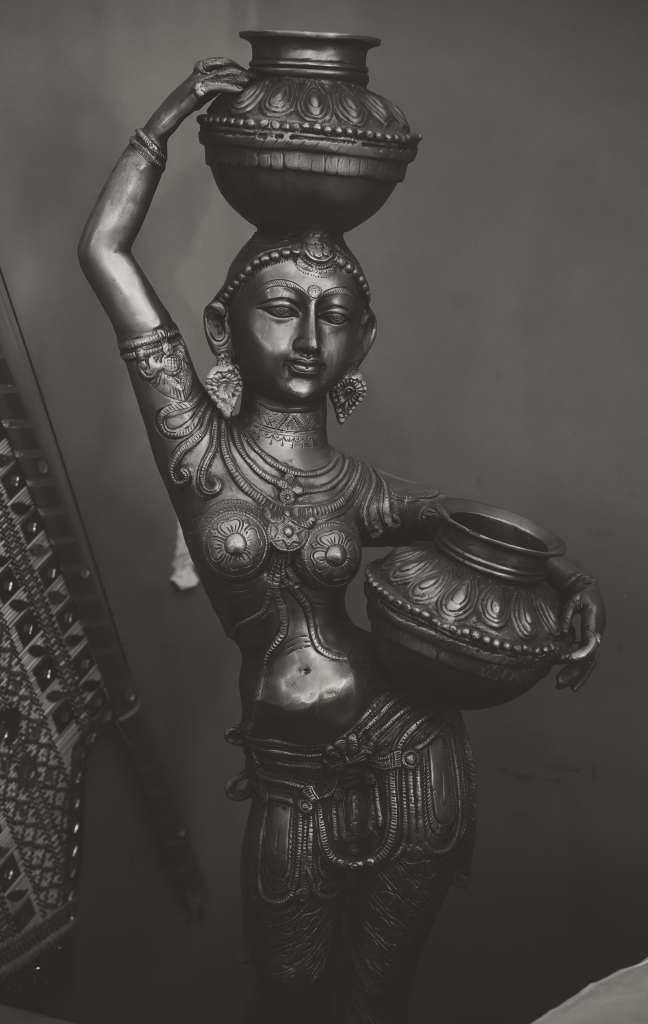Indian sculpture, with its rich history, beautifully captures the multi-dimensional roles of women, representing both divinity and earthly powers. From the ancient depictions of fertility goddesses to the powerful representations of goddesses like Durga and Lakshmi, these figures reveal the complex and symbolic meanings embedded in the art.

In this article, we explore the hidden meanings behind women in Indian sculpture, focusing on how female figures have been depicted as goddesses, symbols of fertility, and guardians of wisdom and power.
Visit our website for more detailed insights.
Women As Goddesses: The Pillars Of Indian Art
The Worship Of The Great Mother
In the ancient civilisations of India, women were revered as embodiments of fertility, creation, and nurturing forces. The Indus Valley Civilisation (c. 2300-1700 BCE) presented female figures that were part of fertility cults. These figurines, crafted primarily in terracotta, symbolise the Mother Goddess, believed to bring life and prosperity to the earth.
- Terracotta Figures: These small figurines, often crafted with minimalistic features, signify women’s nurturing and life-giving roles.
- The Womb Symbolism: The pot, representing the womb, is a recurring motif in ancient sculptures, symbolising creation and fertility. The women depicted were thought to be direct representations of the earth, embodying the source of all life.
The Dual Nature Of Female Deities
Indian art often portrays female deities with dual aspects: as independent entities and as counterparts to male deities. A prime example of this duality is the goddess Durga, who embodies nurturing energy and destructive power. Durga’s image, particularly in the famous sculpture of her slaying the buffalo demon Mahishasura, reflects the fierce protective aspect of the feminine divine.
- Durga’s Power: Durga is often depicted with multiple arms, each holding different weapons, which signify her ability to combat evil forces.
- Lakshmi and Saraswati: These goddesses represent different aspects of wealth and wisdom, respectively. Lakshmi, the goddess of wealth, is often surrounded by elephants, symbolising strength and abundance. At the same time, Saraswati is depicted as the goddess of knowledge, often seated with a veena, a symbol of learning and creativity.
Sculptural Evolution Of Women As Divine Figures
The iconography of women in Indian sculptures evolved significantly over time, adapting to changing religious and cultural beliefs.
- Early Sculptures: In the Kushan period (c. 1st-3rd century CE), representations of goddesses riding lions emerged, symbolising strength and courage.
- The Classical Era: In temples like those in Ellora and Mammalapuram, goddesses like Durga and Lakshmi were portrayed as protectors and symbols of cosmic balance. Sculptures during this period highlighted the goddess’s role in the cosmic order, with multiple arms and dynamic postures conveying their supreme abilities.
Symbolism Of Women In Nature: The Yakshis And Nature Goddesses
Nature And Fertility
Women in Indian sculpture were frequently depicted as representations of nature, embodying the forces of the earth, rivers, and seasons. Yakshis, nature goddesses in early Indian art, are shown in many sculptures as influential yet nurturing figures.
- The Role of Yakshis: These figures are often associated with fertility, health, and prosperity. A notable example is the statue of a smiling Yakshi from the Gupta period, which signifies maternal compassion and the sustaining power of nature.
- River Goddesses: Rivers like Ganga and Yamuna were personified as female deities, with sculptures often depicting them as women riding their respective animal vahanas (vehicles). These deities were seen as the life-givers, sustaining the land with water.
Women As Guardians Of Knowledge And Culture
Beyond their roles as creators, women in Indian sculpture are also seen as bearers of knowledge, wisdom, and tradition. In folk societies, women were central to transmitting oral traditions, which included stories, rituals, and songs that conveyed moral and ethical values.
- Saraswati: As the goddess of knowledge, Saraswati represents femininity’s intellectual and spiritual aspects. Her sculpture image often shows her seated on a lotus, playing the veena, symbolising the harmony between wisdom and creativity.
- Ragini and Sandhya: Female figures representing the morning and evening are found in many medieval miniature paintings and sculptures, illustrating the importance of the feminine principle in maintaining the cycle of life and time.
Women And The Power Of Creation: The Feminine As Divine Origin
The Creation Myth: Woman As The Source Of All Life
Indian sculpture often portrays women as the creators of life, paralleling the male deity, Brahma, who is considered the creator in Hindu mythology. The idea that women give birth to life and preserve it aligns with the symbolism of the Mother Goddess.
- Brahma and the Goddess: Just as Brahma creates, the goddess nurtures and protects life. This dual role of creation and protection is often symbolised in sculptures where the female deity is depicted with the child or as the embodiment of the universe itself.
- Shakti and the Feminine Force: In many sculptures, Shakti, or feminine power, is depicted as an essential force behind the divine energy that sustains the world. This energy is creative and destructive, showing the multifaceted nature of feminine power.
Motherhood And Nurturing In Sculpture
One of the most significant aspects of women in Indian sculpture is their role as mothers. The depiction of goddesses in nurturing postures reflects the importance of motherhood in Indian society.
- Nurturing Postures: Sculptures of goddesses like Lajja Gauri, depicted in a seated posture with her legs spread wide, symbolise fertility and the nurturing aspect of the feminine divine.
- The Mother-Goddess as Protector: As protectors of children and families, the mother goddesses are often shown with protection symbols, such as shields or the lion as their vahana, highlighting their role as guardians of life.
The Role Of Women In Indian Folk Art
Women As Carriers Of Oral Tradition
In folk societies, women were not only creators but also the active bearers of oral traditions. Often spontaneous and functional, folk art in India relied on women to pass down stories, myths, and knowledge through songs and art.
- Women and Rituals: In many parts of India, women play a crucial role in conducting rituals and ceremonies, especially those related to fertility, harvest, and family welfare.
- Folk Art as a Medium of Expression: Women’s art often depicted everyday life, rituals, and family values. Folk art’s decorative patterns and motifs are aesthetic and symbolic representations of fertility, prosperity, and protection.
Conclusion
Indian sculpture depicts women with rich symbolism and meaning. Women have been central to India’s artistic and religious expressions, from the early fertility goddesses of the Indus Valley to the complex portrayals of Durga and Lakshmi in later periods.
Through their representations as goddesses, nature symbols, and cultural carriers, women in Indian sculpture have conveyed the vital forces of creation, preservation, and destruction, all necessary to balance life. These figures reflect the artistic genius of ancient sculptors and the deep reverence for the feminine in Indian culture.
Frequently Asked Questions
What Is The Significance Of Women In Indian Sculpture?
Women in Indian sculpture are often portrayed as goddesses representing key aspects of life, such as fertility, wisdom, and protection. They embody both nurturing and powerful forces, reflecting the dual roles women play in society as creators and guardians. These depictions showcase the reverence for the feminine principle in Indian culture, illustrating the importance of balance in the cosmic order.
How Do Goddesses Like Durga And Lakshmi Contribute To The Meaning Of Women In Indian Art?
Goddesses like Durga and Lakshmi are central figures in Indian sculpture, symbolising strength, wealth, and spiritual wisdom. With her multiple arms and weaponry, Durga represents the protective and warrior aspect of femininity, while Lakshmi, often depicted with wealth and abundance, highlights the nurturing and prosperous qualities of the feminine. Both goddesses reflect women’s holistic roles in both divine and earthly contexts.
How Does Folk Art In India Portray Women?
In Indian folk art, women are depicted as vital carriers of cultural traditions and rituals. They are often shown participating in daily life, fertility rituals, and celebrations, emphasising their roles through symbols of nurturing, protection, and creativity. These artistic expressions highlight women’s contributions to transmitting knowledge, rituals, and oral traditions within communities.
